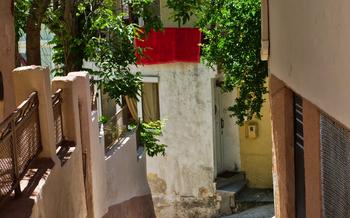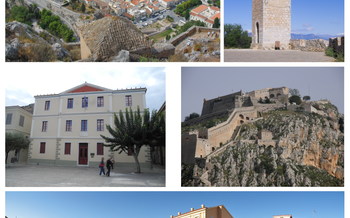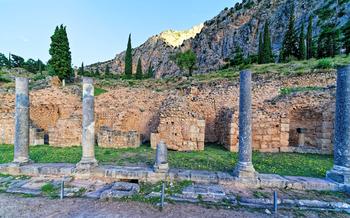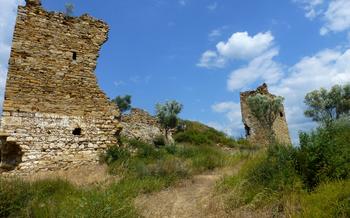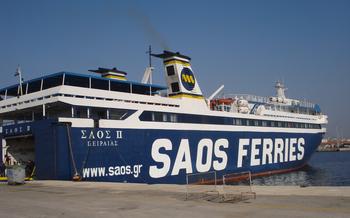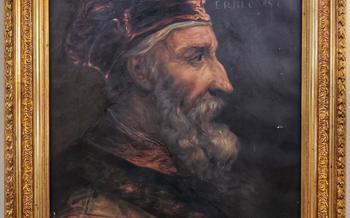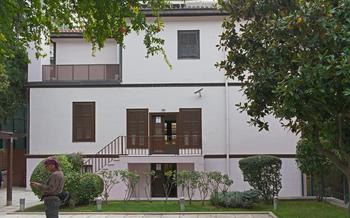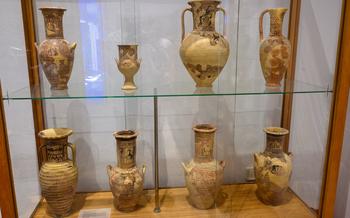
The Maritime Museum of Samothraki
- History of the Museum
- Location and Accessibility
- Museum's Collections
- Exhibits and Displays
- Shipwreck Discoveries
- Ancient Maritime Practices
- Shipbuilding and Craftsmanship
- Naval Battles and Conflicts
- Educational Programs and Workshops
- Research and Publications
- Community Engagement and Outreach
- Collaboration and Partnerships
- Insider Tip:
History of the Museum
Samothraki, an island steeped in ancient history and mythology, played a significant role in the maritime world of the Aegean Sea. The city of Samothraki, founded in the 8th century BC, served as a vital port and a sacred sanctuary for the worship of the Great Gods, attracting pilgrims and traders from across the region.
The Maritime Museum of Samothraki, established in 1988, is dedicated to preserving and showcasing the rich maritime heritage of the island. Housed in a charming neoclassical building overlooking the picturesque harbor, the museum offers a fascinating glimpse into the seafaring traditions and maritime culture of Samothraki throughout the ages.
Through its diverse collections, interactive exhibits, and educational programs, the museum aims to educate and inspire visitors, fostering an appreciation for the island's maritime history and its enduring connection to the sea.
Location and Accessibility
The Maritime Museum of Samothraki finds its home in the picturesque town of Kamariotissa, directly across from the island's main port. Its strategic position ensures effortless accessibility for travelers arriving from various destinations. Whether you choose to embark on a scenic road trip, hop aboard a comfortable bus, or glide across the sea on a ferry, reaching the museum is a breeze.
For those who prefer the freedom of a self-guided journey, driving to the museum is a delightful option. Simply follow the well-maintained roads that lead to Kamariotissa, and within minutes, you'll find yourself immersed in the tranquil surroundings of the port area. Public transportation is equally convenient, with buses regularly departing from Alexandroupoli, the capital of the Evros region. These buses offer a budget-friendly and comfortable mode of transportation, allowing you to soak in the stunning coastal views along the way.
For those arriving by sea, the Maritime Museum is just a stone's throw away from the ferry terminal. As your vessel docks in the tranquil harbor of Kamariotissa, you'll be greeted by the museum's distinctive facade, beckoning you to explore the rich maritime heritage that awaits within.
In proximity to the museum, a treasure trove of attractions and landmarks awaits your discovery. The Archaeological Museum of Samothraki, housing a remarkable collection of ancient artifacts, is a mere stone's throw away. Nature enthusiasts will find solace in the pristine beaches that dot the island's coastline, inviting you to bask in the sun, swim in crystal-clear waters, or embark on invigorating hikes amidst breathtaking scenery.
Museum's Collections
The Maritime Museum of Samothraki boasts a treasure trove of artifacts that provide a fascinating glimpse into the maritime history of the island and the surrounding region. Among the highlights of the collection are the remains of ancient shipwrecks, meticulously preserved and displayed to showcase the ingenuity and craftsmanship of ancient shipbuilders. These shipwrecks offer a tangible connection to the past, allowing visitors to imagine the lives of the sailors who braved the treacherous seas in search of adventure, trade, and exploration.
Notable Exhibits:
-
Ancient Shipwrecks: The museum houses the remains of several ancient shipwrecks discovered in the waters surrounding Samothraki. These wrecks date back to different periods, providing a cross-section of maritime technology and design throughout history. Visitors can examine the well-preserved hulls, masts, and other components of these vessels, gaining insights into the construction techniques and seafaring capabilities of ancient civilizations.
-
Artifacts from Underwater Excavations: Alongside the shipwrecks, the museum displays a rich collection of artifacts recovered from underwater excavations. These artifacts include pottery, tools, weapons, and personal items that offer a glimpse into the daily lives of ancient mariners. Visitors can marvel at the intricate designs of ceramic ware, the functionality of bronze tools, and the elegance of jewelry, all of which speak to the cultural and technological advancements of the time.
-
Maritime Tools and Equipment: The museum also showcases a variety of maritime tools and equipment used by sailors throughout the centuries. These include anchors, navigation instruments, fishing gear, and shipbuilding tools. By examining these artifacts, visitors can gain a deeper understanding of the challenges and techniques involved in ancient seafaring, as well as the ingenuity of those who relied on the sea for their livelihood.
Exhibits and Displays
The Maritime Museum of Samothraki boasts a diverse collection of permanent and temporary exhibits that bring the rich maritime heritage of the island to life. Permanent exhibits focus on the ancient city of Samothraki and its connection to the sea, showcasing shipwrecks, artifacts, and maritime tools that provide a glimpse into the seafaring traditions of the region.
Visitors can explore the remains of ancient shipwrecks, including the well-preserved wreck of a Roman ship that sank off the coast of Samothraki. This remarkable discovery offers a unique opportunity to study the construction and design of ancient vessels. The museum also displays a collection of anchors, amphorae, and other artifacts recovered from underwater excavations, providing insights into ancient trade routes and maritime activities.
Temporary exhibits at the museum often focus on specific aspects of maritime history or feature special collections from other institutions. These exhibits provide a dynamic and engaging experience for visitors, allowing them to delve deeper into the fascinating world of seafaring and exploration.
Interactive displays and multimedia presentations enhance the museum experience, making it accessible and enjoyable for visitors of all ages. Touchscreens, interactive maps, and virtual reality experiences bring the exhibits to life, allowing visitors to explore shipwrecks, navigate ancient sea routes, and learn about the daily lives of mariners in the ancient world.
Shipwreck Discoveries
The waters surrounding Samothraki have yielded a treasure trove of ancient shipwrecks, offering a glimpse into the maritime history of the region. Underwater excavations have revealed the remains of merchant vessels, warships, and fishing boats, shedding light on trade routes, navigation techniques, and daily life at sea.
One of the most significant discoveries was the wreck of a 5th-century BC merchant ship, found off the coast of Kamariotissa. The ship, remarkably well-preserved, contained a cargo of amphorae, pottery, and other artifacts, providing valuable insights into ancient trade practices.
Another notable find was the wreck of a Byzantine warship, dating back to the 10th century AD. The ship, discovered near the island's capital, contained a wealth of artifacts, including weapons, armor, and navigational instruments, offering a glimpse into the naval warfare of the period.
These discoveries, along with many others, have contributed to our understanding of ancient maritime activities in the Aegean Sea. They provide tangible evidence of the importance of Samothraki as a strategic location for trade, naval power, and cultural exchange.
Ancient Maritime Practices
The Maritime Museum of Samothraki offers a fascinating glimpse into the ancient seafaring practices and navigation techniques used in the region. Samothraki's strategic location at the crossroads of the Aegean Sea made it a critical hub for maritime activities in antiquity. The island's skilled mariners navigated the treacherous waters using celestial bodies, landmarks, and rudimentary instruments like the astrolabe.
The museum's exhibits showcase replicas of ancient vessels, including the monoxyle, a dugout canoe, and the penteconter, a 50-oared warship. Visitors can learn about the construction techniques, propulsion systems, and rigging of these vessels, gaining insights into the challenges and ingenuity of ancient seafarers.
Ancient mariners relied on a deep understanding of the winds, currents, and weather patterns to plan their voyages. The museum's exhibits explain the significance of the prevailing winds, such as the Meltemi, and how sailors used their knowledge of these winds to optimize their routes.
The daily lives of ancient mariners were marked by both adventure and hardship. They faced the perils of storms, pirates, and unfamiliar shores. The museum's displays include personal artifacts such as cooking utensils, tools, and navigational instruments, offering a glimpse into the daily routines and challenges of these intrepid seafarers.
Shipbuilding and Craftsmanship
Samothraki's rich maritime history is not just about seafaring and trade; it also encompasses a proud tradition of shipbuilding and craftsmanship. The island's skilled shipbuilders have a long-standing reputation for constructing sturdy and seaworthy vessels, using techniques passed down through generations.
One of the most notable types of vessels built in Samothraki was the "samarakos," a traditional fishing boat characterized by its distinctive design and construction. These boats were crafted from local wood, carefully shaped and joined to withstand the challenging conditions of the Aegean Sea. The samarako's unique features, such as its high stern and curved bow, allowed it to navigate the unpredictable waters effectively and safely.
Shipbuilding in Samothraki was a family affair, with fathers passing down their skills and knowledge to their sons, ensuring the continuity of this ancient craft. The shipyards were a hub of activity, where the rhythmic sound of hammers and the smell of fresh wood filled the air. Each vessel was meticulously crafted, with attention to detail and a deep understanding of the sea's demands.
Today, the tradition of shipbuilding in Samothraki continues, albeit on a smaller scale. Visitors to the island can still witness the skilled hands of local craftsmen shaping wood into beautiful and functional vessels, carrying on a legacy that has stood the test of time.
Naval Battles and Conflicts
Samothraki's strategic location in the northern Aegean Sea made it a focal point for naval battles and conflicts throughout history. The island's proximity to major trade routes and its natural harbor provided a safe haven for ships, but also made it a target for rival powers seeking to control the region.
One of the most significant naval battles took place in 494 BC, when the Persian fleet under the command of Mardonius clashed with the Greek fleet led by the Athenian general Xanthippus. The battle, known as the Battle of Lade, resulted in a decisive victory for the Greeks, who destroyed the Persian fleet and secured their control over the Aegean Sea.
In the Byzantine era, Samothraki was frequently raided by Arab pirates, who took advantage of the island's exposed position to launch attacks on Byzantine ships and coastal settlements. The Byzantines constructed a series of fortifications on the island to protect against these raids, but the island remained vulnerable to attack.
During the Ottoman period, Samothraki was the site of several naval skirmishes between the Ottoman navy and European powers, including the Venetians and the Russians. The island's strategic importance persisted into the modern era, as it was used as a base by the Greek navy during the Balkan Wars and the First World War.
Educational Programs and Workshops
The Maritime Museum of Samothraki recognizes the importance of educating the younger generation about maritime heritage and seafaring traditions. To this end, the museum offers a range of educational programs and workshops tailored to different age groups and interests. School groups are particularly encouraged to visit the museum, where they can participate in interactive workshops that bring maritime history to life. These workshops may include hands-on activities such as model ship building, rope knotting, or navigation exercises using traditional instruments. The museum's knowledgeable staff is passionate about sharing their expertise and fostering a love for the sea among young minds.
One of the most popular educational programs is the "Junior Mariners" workshop, which invites children to embark on a journey through time, learning about ancient seafaring practices, shipwrecks, and maritime exploration. Through storytelling, games, and interactive displays, children are encouraged to use their imaginations and explore the wonders of the underwater world. The museum also hosts regular workshops for adults, covering topics such as maritime archaeology, shipbuilding techniques, and the history of navigation. These workshops provide an opportunity for participants to delve deeper into the fascinating world of maritime heritage and gain a newfound appreciation for the sea and its significance in human history.
Research and Publications
The Maritime Museum of Samothraki is not merely a repository of artifacts and exhibits; it is also a hub for maritime research and scholarship. The museum's dedicated team of researchers and archaeologists actively engages in underwater excavations, surveys, and studies to uncover the rich maritime history of the region. Their findings are meticulously documented and disseminated through publications, research papers, and books, contributing significantly to the field of maritime studies. These publications provide valuable insights into ancient seafaring practices, trade routes, shipbuilding techniques, and naval conflicts, shedding light on the maritime heritage of Samothraki and the broader Mediterranean region.
Community Engagement and Outreach
The Maritime Museum of Samothraki extends its reach beyond its walls through active community engagement and outreach initiatives. By organizing events, exhibitions, and workshops, the museum aims to foster a sense of maritime awareness and appreciation among the local community and visitors alike. These events provide a platform for learning, sharing, and celebrating the rich maritime heritage of the island.
One notable initiative is the annual "Maritime Festival," which attracts locals and tourists alike. The festival features a variety of activities, including boat races, traditional music and dance performances, culinary demonstrations, and educational workshops. It's an opportunity for the museum to showcase its collections, engage with the community, and promote the importance of preserving maritime traditions.
The museum also collaborates with local schools to offer educational programs and workshops for students of all ages. These programs aim to instill an appreciation for maritime history and archaeology, as well as the importance of protecting the marine environment. Through hands-on activities, interactive presentations, and field trips, students gain a deeper understanding of the island's maritime heritage and its significance in shaping the local culture and economy.
By actively engaging with the community, the Maritime Museum of Samothraki plays a vital role in preserving and promoting the island's rich maritime legacy, ensuring that future generations can appreciate and learn from the treasures of the sea.
Collaboration and Partnerships
The Maritime Museum of Samothraki actively collaborates with other institutions, universities, and organizations to advance maritime research, preservation, and education. These partnerships play a crucial role in expanding the museum's reach, accessing specialized expertise, and contributing to the broader field of maritime studies.
One notable collaboration is with the University of Thrace, Department of History and Archaeology. Together, they conduct joint research projects, organize conferences and workshops, and share resources to enhance the understanding of Samothraki's maritime history and archaeology.
The museum also collaborates with the Hellenic Ministry of Culture and Sports, receiving support for research, conservation, and educational initiatives. This partnership ensures that the museum's work aligns with national priorities for preserving and promoting Greece's rich maritime heritage.
Additionally, the museum collaborates with international institutions such as the Institute of Nautical Archaeology (INA) in the United States. Through this partnership, the museum gains access to specialized expertise in underwater archaeology, contributing to the exploration and documentation of shipwrecks around Samothraki.
These collaborations have resulted in significant achievements, including the publication of research papers, the organization of international conferences, and the development of educational programs. The museum's commitment to collaboration and partnerships ensures that it remains at the forefront of maritime research and preservation, offering valuable contributions to the field.
Insider Tip:
For an immersive experience, plan your visit to the Maritime Museum of Samothraki during the annual "Samothraki Sea Festival." Held in the summer months, this vibrant festival showcases traditional boat building, sailing competitions, live music, and delicious seafood delicacies. It's a fantastic opportunity to witness the island's maritime heritage come alive and interact with local seafarers and craftspeople. Don't miss the chance to join in the festivities and create lasting memories of your visit to this enchanting island.
